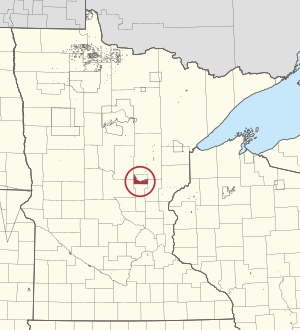Mille Lacs Indian Reservation facts for kids
The Mille Lacs Indian Reservation is the main homeland for the Mille Lacs Band of Ojibwe, a Native American tribe in Central Minnesota. It's located about 100 miles (160 km) north of Minneapolis-St. Paul. The Mille Lacs Band owns land in several counties, including Mille Lacs, Pine, Aitkin, and Crow Wing. The reservation was officially created in 1855. Today, the Mille Lacs Band includes many Ojibwe groups and communities across central Minnesota.
Contents
Ojibwe Homelands
The Mille Lacs Band of Ojibwe has two main land areas that are considered formal reservations.
Mille Lacs Lake Reservation
The main part of the Mille Lacs Indian Reservation is called the Mille Lacs Lake Indian Reservation. In the Ojibwe language, it's known as Misi-zaaga'iganiing. It's located at the southern end of Mille Lacs Lake. This area covers about 61,000 acres (247 km²) of land, including islands in the lake.
This reservation was first set up in 1855 by the Treaty of Washington. It was meant for the Mille Lacs and other Ojibwe bands. Over time, some land was opened up for non-Native American settlers and logging. However, in 2022, a court confirmed that the land set aside in the 1855 treaty still has federal reservation status.
This reservation includes the communities of Neyaashiing (Vineland) and Chi-minising (Isle).
- Neyaashiing is home to the Mille Lacs Band's government center and schools. It also has the Mille Lacs Indian Museum and the Grand Casino Mille Lacs.
- The Band also owns Woodland National Bank and health insurance offices in Onamia, Minnesota, which is within the reservation.
- Chi-minising has a community center and government services.
Sandy Lake Reservation
The Mille Lacs Band also has land in the Sandy Lake Indian Reservation. In Ojibwe, it's called Gaa-mitaawangaagamaag. This reservation is in Aitkin County and surrounds Big Sandy Lake. It covers about 20,192 acres (81.7 km²) of land.
Like the Mille Lacs Lake Reservation, it was also created in 1855. Most of the land here is now owned by non-Native Americans. However, Ojibwe communities like Gaa-mitaawangaagamaag and Chi-manoominikaang are located near or within this reservation. The United States Army Corps of Engineers operates a small dam here to control floods.
Other Land Holdings
The Mille Lacs Indian Reservation also includes smaller pieces of land, less than 80 acres (32 ha) each. These are spread out in Pine, Kanabec, Aitkin, Crow Wing, and Morrison Counties. The Band also helps maintain a wild rice harvesting area at Star Lake.
Community Districts
Because the Mille Lacs Band of Ojibwe lives across a large area, their lands are divided into different administrative districts.
District I
The Neyaashiing District (District I) serves Band members in the western part of the Misi-zaaga'iganiing Reservation. Its main office is in Neyaashiing Community (Vineland, Minnesota).
District II
The Gaa-mitaawangaagamaag District (District II) serves Band members in the eastern part of the Misi-zaaga'iganiing Reservation and all of the Gaa-mitaawangaagamaag Reservation. This district includes the Chi-manoominikaang and Minisinaakwaang communities.
District II is split into two sub-districts:
- District IIa is linked to the Chi-minising Community (Isle, Minnesota).
- District IIb includes the rest of District II. The Minisinaakwaang Community (East Lake, Minnesota) has a community and government services center for District IIb.
District III
The Aazhoomog District (District III) is mostly in Pine County. It includes communities like Ne-zhingwaakokaag (Pine City-Rock Creek), Gaa-zhiigwanaabikokaag (Hinckley), and Asiniikaaning (Sandstone). These communities have been connected to the Mille Lacs Band since the 1800s.
The Aazhoomog Village has a community and government service center, plus a health clinic. In Gaa-zhiigwanaabikokaag, you'll find Grand Casino Hinckley and its related businesses, like a golf course and concert hall.
Urban Area Services
The Urban Area is a special district that helps the many Mille Lacs Band members who live in the Twin Cities area. It provides various tribal services, including affordable housing for eligible Band members.
Population Information
According to the 2020 census, the total population of the Mille Lacs Reservation and its trust lands was 4,767 people. The reservation has many non-Native American residents. This is partly because some Ojibwe lands were sold in the late 1800s and early 1900s.
In 2020, about 31.8% of the population was Native American, and 60.6% was White. Other groups made up smaller percentages. About 2.7% of the population was Hispanic or Latino.
Communities of the Band
The Mille Lacs Band of Ojibwe has ten official communities and six informal ones.
|
Ten official communities:
|
Six informal communities:
|
Education for Kids
The Mille Lacs Band operates its own tribal schools:
- Nay Ah Shing School has a lower school (Abinoojiiyag School) and an upper school at the Vineland Campus.
- Pine Grove Academy is located at the Lake Lena Campus.
- In East Lake, the tribe runs the Minisinaakwaang Leadership Academy, which is a Minnesota charter school.
Many Ojibwe children also attend public schools in the towns and cities near the reservation.


